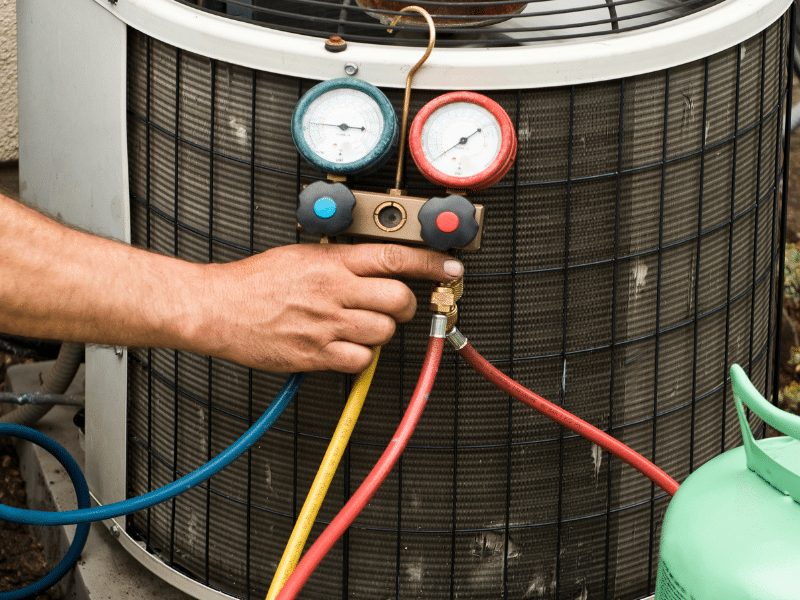Refrigerant recovery is an essential process in HVAC systems to ensure the safe extraction of refrigerants without causing harm to the environment. Understanding how to use a recovery machine is crucial for anyone involved in HVAC maintenance or repairs. In this guide, we will provide detailed instructions on using a recovery machine, along with an overview of the machine’s functionality, the possibility of reusing recovered refrigerants, and the concepts of recycling and regeneration. By following these instructions, you can confidently operate a recovery machine and contribute to environmentally responsible HVAC practices.
Step-By-Step Instructions For Using A Recovery Machine

Step 1: Connect The Hoses
To begin, connect the high side and low side hoses of the recovery machine to the respective points on the HVAC system. Make sure to turn off the gauges and the HVAC system before proceeding. Remember that the red hose connects to the high side, while the blue hose connects to the low side. The suction line of the recovery machine should be connected to the yellow hose, labeled as “IN.”
Step 2: Weigh Your Recovery Tank
Before initiating the recovery process, connect one hose between the recovery tank and the recovery machine. Place the recovery tank on a scale and record its weight. This measurement will help you track the amount of refrigerant being extracted. It is important not to overfill the recovery tank, as regulations typically prohibit filling it beyond 80% capacity.
Step 3: Unscrew The Valve
To remove air from the hoses, open the appropriate valves on the recovery machine and allow air to escape from the tank side. Be sure to tighten the valve after a brief period to ensure that air is expelled while the refrigerant remains pressurized.
Step 4: Start The Recovery System
Once the valves are reconnected, start the recovery machine. As the refrigerant is drawn into the machine, you will observe a drop in pressure. Allow the machine to run until the low side pressure reaches 0 psi.
Step 5: Begin The Purge Cycle
Once the pressure reaches 0 psi, switch the recovery unit to “purge” mode by adjusting the red and blue valves accordingly. Confirm that the gauges reflect the transition from high to low pressure. The recovery machine will shut itself off after completing the purge cycle. Finally, close all valves, particularly the one leading to the refrigerant recovery tank.
Understanding The Recovery Machine
A recovery machine is a specialized equipment used to extract refrigerants from HVAC systems. Due to the harmful effects of refrigerant discharge into the environment, recovery machines are crucial for responsible HVAC maintenance. These machines create a vacuum and suction the refrigerant from the system into a storage tank after passing it through a filter for cleaning.
Reusing Recovered Refrigerants

While it is possible to reuse recovered refrigerants, caution must be exercised to avoid using contaminated refrigerants. Recovered refrigerants may contain pollutants, air, or other coolants, rendering them unsuitable for reuse without proper verification and cleaning. Any recovered refrigerant should undergo thorough testing and analysis to ensure its cleanliness before being reintroduced into the same or another system.
Refrigerant Recovery, Recycling, And Regeneration
Refrigerant recovery, recycling, and regeneration are integral to responsible HVAC practices and environmental preservation.
Refrigerant Recovery: This process involves safely extracting refrigerant from an HVAC system and storing it in a designated container without further processing or analysis. Adhering to regulations regarding the handling of refrigerants is essential to maintain a clean and uncontaminated atmosphere.
Refrigerant Recycling: Recycling entails cleaning the recovered refrigerant to remove impurities, moisture, and acidity. Specialized facilities perform this process using dehydrating filters or desiccant blocks to separate pollutants. Although recycling significantly reduces pollutants, it does not guarantee that the refrigerant will reach its original purity standards.

Refrigerant Regeneration: Regeneration involves advanced cleaning processes, including filtering, drying, distillation, and chemical treatment. Regenerated refrigerants undergo rigorous analysis at specialized facilities to determine their suitability for reuse. The quality control measures applied during regeneration ensure that the regenerated refrigerants match the original specifications. Regenerated refrigerants are then delivered in appropriately labeled containers with corresponding certificates.
Conclusion
Using a recovery machine is a straightforward process when following the provided instructions. Properly connecting the hoses, weighing the recovery tank, unscrewing the valve, starting the recovery system, and initiating the purge cycle are the key steps to ensure successful refrigerant recovery. Additionally, understanding the functionality of a recovery machine, the precautions associated with reusing recovered refrigerants, and the concepts of recycling and regeneration contribute to environmentally responsible HVAC practices. By implementing these guidelines, you can contribute to a cleaner and more sustainable future while maintaining HVAC systems effectively.






GIPHY App Key not set. Please check settings